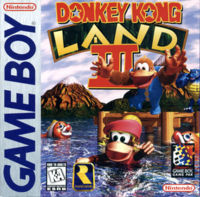Donkey Kong Land III

| |
| Donkey Kong Land III | |
| Developer | Rare |
| Publisher | Nintendo |
| System | Game Boy, Game Boy Color, 3DS Virtual Console |
| Release Date | Game Boy US October 1997 EU October 30, 1997 Game Boy Color JP January 28, 2000 3DS Virtual Console JP May 7, 2014 (GBC) EU October 30, 2014 US February 26, 2015 |
| Rating | ESRB: K-A |
Donkey Kong Land III (known in Japan as Donkey Kong GB: Dinky Kong & Dixie Kong) is the final game of the Donkey Kong Land trilogy, and it was released as a companion for Donkey Kong Country 3: Dixie Kong's Double Trouble. It would be the last side-scrolling Donkey Kong game to be released until Donkey Kong: Jungle Beat. While it came out in most regions as a Game Boy game, it took longer to be released in Japan, and it ended up being released as a Game Boy Color game. That version featured some minor tweaks, in addition to being colorized.
Story[edit]
Most of Donkey Kong Island, including Donkey Kong and Diddy Kong have gone off to find the mysterious "Lost World". Eventually Dixie Kong and Kiddy Kong decide to go off on the adventure and they come into conflict with the Kremlings along the way.
Gameplay[edit]
The game is similar to Donkey Kong Country 3 in most ways, although not to the degree that Donkey Kong Land 2 is to Donkey Kong Country 2: Diddy's Kong Quest. This game also reverts to normal world maps. The only supporting characters appearing in this game are Wrinkly Kong (once again saving games) and an unnamed Bear (who plays card games). However, there is still an unlockable "Lost World".
Legacy[edit]
It is the last of the Donkey Kong Land games as well as the last Donkey Kong sidescroller made by Rare. The next Donkey Kong games made by Rare were Diddy Kong Racing and Donkey Kong 64.
Ports/Remakes[edit]
- In 2014 (2015 in America), it was released for download through the 3DS eShop as pat of the 3DS Virtual Console. The releases matched the original system release, so in Japan the Game Boy Color version was used, while in America and Europe the Game Boy version was used.
| Titles in the Donkey Kong Series |
|---|
| Donkey Kong (GB) - Jr. - Math - 3 Donkey Kong Country (2: Diddy Kong's Quest - 3: Dixie Kong's Double Trouble) - Land (2 - III) - Donkey Kong 64 Mario vs. Donkey Kong - March of the Minis - Minis March Again! - Mini-Land Mayhem! - Minis on the Move - Tipping Stars Jungle Beat - King of Swing - Jungle Climber - Returns - Tropical Freeze Diddy Kong Racing - Donkey Konga (2 - 3) - Barrel Blast |